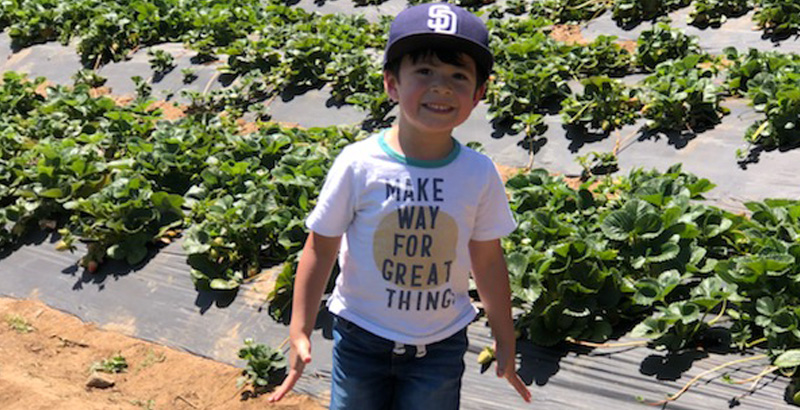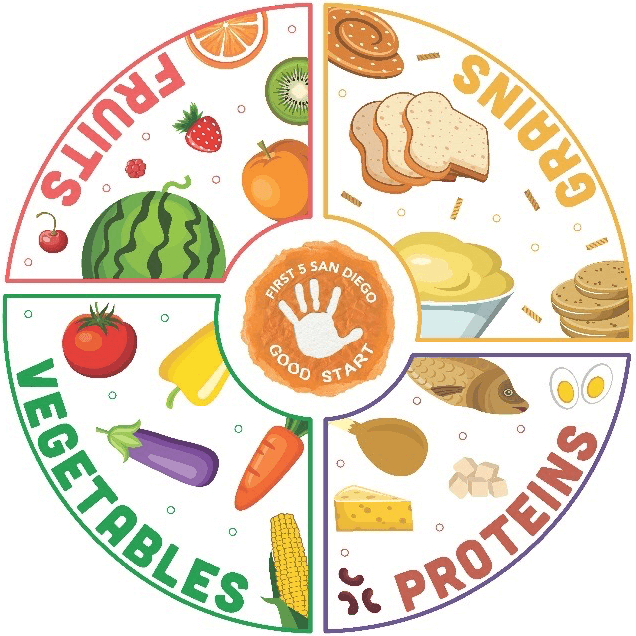
Whether you’re a first-time parent with a newborn at home or a “seasoned” vet, determining when to work with your child on nutrition can be difficult. There are many questions parents may have regarding nutritional sources for your child(ren). A great resource available to you is the State of California’s KIT for New Parents and First 5 San Diego’s “First 1,000 Day’s Brochure.” As discussed in our last newsletter, this brochure talks about child development and needs for 270 days Prenatal, 365 days (Year 1) and 365 days (Year 2). Nutrition is a big part of the information.
0-6 Months Nutrition
For the first 6 months of a child’s life, feeding should be the simplest. During this period, you should be feeding your child breastmilk or formula depending on dietary and health needs. As the child continues to grow, you should check for developmental milestones to help determine when your child will be able to slowly transition to soft foods and purees. According to Healthychildren.org, watching your child’s behaviors can help you better understand their dietary needs and feeding transitions from milk/formula to soft foods and solid foods.
- When your child hits different miles stones listed below, you should then consider transitioning your child to additional nutritional sources. When your child begins…
- holding their head up by themselves
- sitting up with support
- opening and closing their mouth around a spoon
- signaling to you that they are full by using head movements (turning away)
- swallowing food instead of spitting it out
It is common that you will begin to see these eating habits around 6 months of age. Once you notice these behaviors it is likely they are ready to begin a solid food diet. When in doubt always consult your child’s primary care physician.
6-8 Months Nutrition
From 6 to 8 months of age, one should be close to starting their child on baby cereal and/or pureed foods such as vegetables, fruits, or meats). This is not a complete transition, it is important to still feed your child breastmilk or formula as well. During these transition stages, it is important to only introduce your child to one new food at a time to ensure there are no food allergies. If there is a sign of an allergy, contact emergency support immediately.
Babies aren’t born with food allergies, they develop them based off their environment. Pediatricians often suggest three things to help reduce the development of food allergies: early introduction to foods, diverse diet and routine feedings (Baby Center). An early and consistent introduction of a certain food has been shown to reduce the likelihood of allergy development.
Allergic reactions occur when the body has a reaction to a harmless protein found in certain food items. Look out for signs of skin rashes, breathing difficulties, stomach issues or circulation symptoms (including loss of consciousness and pale skin) which may be signs of an allergic reaction and may require medical attention immediately. If you notice several severely affected areas of the body, seek medical attention immediately or dial 911 because this may be an indication of anaphylaxis (anaphylactic shock) which requires immediate medical attention. It is especially important to look out for these symptoms when introducing your child to foods such as milk, eggs, peanuts and other nuts, fish and shellfish, soy and wheat.
9 – 12 Months
At around 9 to 12 months, your child can try eating finely chopped foods such as fruits, meat, tofu and cooked vegetables (non-pureed). At this point it is important to not give your child more than 3 bottles or cups of breastmilk or formula a day, because you do not want to over feed your child and suppress their appetite for solid foods.
12+ Months (Welcome to Toddlerhood)
Once your child becomes a toddler (beginning around 12 months) they will begin to try to feed themselves and gain independence around the house. This makes this period a crucial time in a child’s life for building lifelong healthy eating habits.
It is recommended that your toddler and/or growing child consumes nutritious foods from the five groups below to maintain a healthy and well-rounded diet on a daily basis.
Food Group | Per Serving | Recommended Servings |
Grains |
| 6 |
Dairy |
| 2-3 |
Fruit |
| 2-3 |
Cooked Veggies |
| 2-3 |
Protein |
| 2-4 |
**Data provided by First 5 California New Parent Kit** |
Making sure your child is taking in food with lots of iron such as whole grain bread, leafy greens, protein, and fish will help your child grow and have plenty of energy throughout the day both for play and for fighting off germs. Additionally, avoiding foods high in fat, salt, and sugar helps promote healthy eating and can help prevent childhood obesity and tooth decay.
First 5 San Diego MyPlate

Teaching your little one to balance and recognize their food groups is made easy with help from the First 5 San Diego MyPlate. With our free and colorful MyPlate, kids can learn both visually and interactively which foods belong in which food groups and learn the importance of eating from every food group. Check out our Twitter, Facebook or Instagram to learn where in the county First 5 will be stopping next so your child can pick up one of their very own! You can pair it with the Potter the Otter Cookbook!
Sources
Information taken from the First 5 California “California Parent Guide”